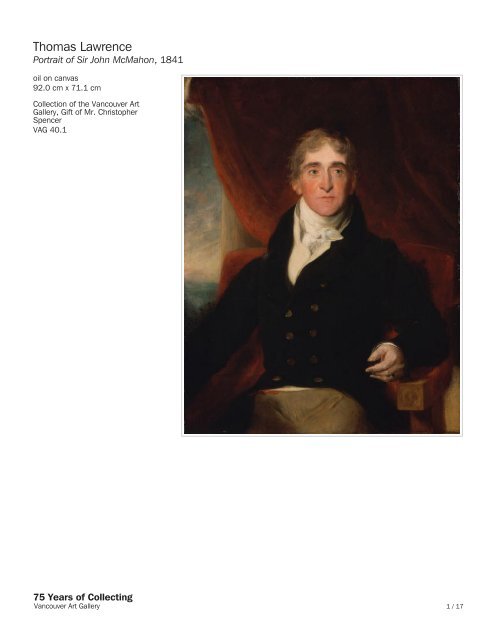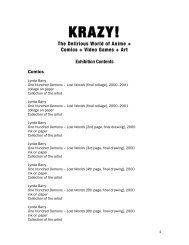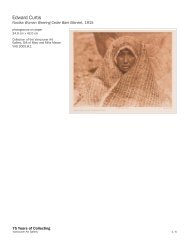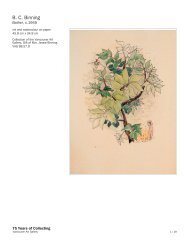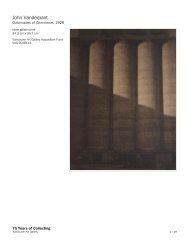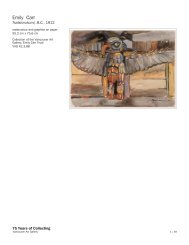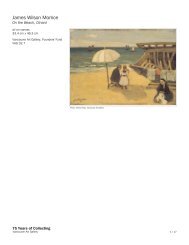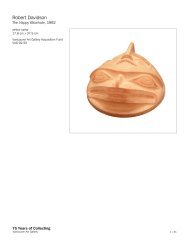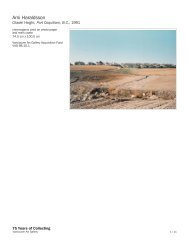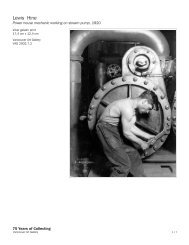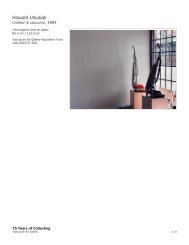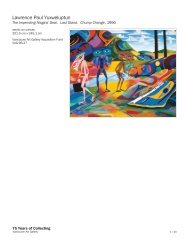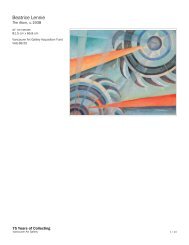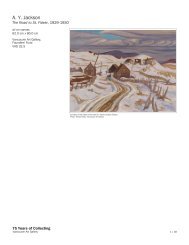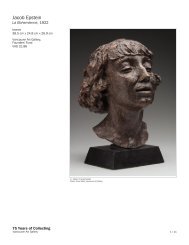Thomas Lawrence - 75 Years of Collecting - Vancouver Art Gallery
Thomas Lawrence - 75 Years of Collecting - Vancouver Art Gallery
Thomas Lawrence - 75 Years of Collecting - Vancouver Art Gallery
You also want an ePaper? Increase the reach of your titles
YUMPU automatically turns print PDFs into web optimized ePapers that Google loves.
<strong>Thomas</strong> <strong>Lawrence</strong><br />
Portrait <strong>of</strong> Sir John McMahon, 1841<br />
oil on canvas<br />
92.0 cm x 71.1 cm<br />
Collection <strong>of</strong> the <strong>Vancouver</strong> <strong>Art</strong><br />
<strong>Gallery</strong>, Gift <strong>of</strong> Mr. Christopher<br />
Spencer<br />
VAG 40.1<br />
<strong>75</strong> <strong>Years</strong> <strong>of</strong> <strong>Collecting</strong><br />
<strong>Vancouver</strong> <strong>Art</strong> <strong>Gallery</strong><br />
1 / 17
<strong>Thomas</strong> <strong>Lawrence</strong><br />
Portrait <strong>of</strong> Sir John McMahon, 1841<br />
Image source: Sir <strong>Thomas</strong> <strong>Lawrence</strong>, Self<br />
Portrait, oil on canvas, c. 1825.<br />
www.royalacademy.org.uk<br />
<strong>75</strong> <strong>Years</strong> <strong>of</strong> <strong>Collecting</strong><br />
<strong>Vancouver</strong> <strong>Art</strong> <strong>Gallery</strong><br />
<strong>Art</strong>ist's Biography<br />
Nationality: British<br />
Born: 1769-04-13, Bristol, England<br />
Died: 1830-01-07<br />
Sir <strong>Thomas</strong> <strong>Lawrence</strong> (April 13, 1769 — January 7, 1830), an English painter,<br />
was born at Bristol.<br />
His father was an innkeeper, first at Bristol and afterwards at Devizes, and at the<br />
age <strong>of</strong> six <strong>Thomas</strong> was already shown <strong>of</strong>f to the guests <strong>of</strong> the Black Boar as an<br />
infant prodigy who could sketch their likenesses and declaim speeches from<br />
Milton. In 1779 the elder <strong>Lawrence</strong> had to leave Devizes, having failed in<br />
business and the precocious talent <strong>of</strong> the son, who had gained a reputation<br />
along the Bath road, became the support <strong>of</strong> the family. His debut as a crayon<br />
portrait painter was made at Oxford, where he was well patronized, and in 1782<br />
the family settled in Bath, where the young artist soon found himself fully<br />
employed in taking crayon likenesses <strong>of</strong> the fashionables <strong>of</strong> the place at a<br />
guinea or a guinea and a half a head. In 1784 he gained the prize and silver-gilt<br />
palette <strong>of</strong> the Society <strong>of</strong> <strong>Art</strong>s for a crayon drawing after Raphael's<br />
Transfiguration, and presently beginning [began] to paint in oil.<br />
Throwing aside the idea <strong>of</strong> going on the stage which he had for a short time<br />
entertained, he came to London in 1787, was kindly received by Reynolds, and<br />
entered as a student at the Royal Academy. He began to exhibit almost<br />
immediately, and his reputation increased so rapidly that he became an<br />
associate <strong>of</strong> the Academy in 1791. The death <strong>of</strong> Sir Joshua in 1792 opened the<br />
way to further successes. He was at once appointed painter to the Dilettanti<br />
Society, and principal painter to the king in lieu <strong>of</strong> Reynolds. In 1794 he was a<br />
Royal Academician, and he became the fashionable portrait painter <strong>of</strong> the age,<br />
having as his sitters all the rank, fashion and talent <strong>of</strong> England, and ultimately<br />
most <strong>of</strong> the crowned heads <strong>of</strong> Europe. Caroline <strong>of</strong> Brunswick was one <strong>of</strong> his<br />
favourite subjects and is reputed to have been his lover for a time. In 1815 he<br />
was knighted; in 1818 he went to Aachen to paint the sovereigns and<br />
diplomatists gathered there, and visited Vienna and Rome, everywhere receiving<br />
flattering marks <strong>of</strong> distinction from princes, due as much to his courtly manners<br />
as to his merits as an artist. After eighteen months he returned to England, and<br />
on the very day <strong>of</strong> his arrival was chosen president <strong>of</strong> the Academy in the room<br />
<strong>of</strong> [Benjamin] West, who had died a few days before. This <strong>of</strong>fice he held from<br />
1820 to his death. He was never married.<br />
Sir <strong>Thomas</strong> <strong>Lawrence</strong> had all the qualities <strong>of</strong> personal manner and artistic style<br />
necessary to make a fashionable painter, and among English portrait painters he<br />
takes a high place, though not as high as that given to him in his lifetime. His<br />
more ambitious works, in the classical style, such as his once celebrated Satan,<br />
are practically forgotten.<br />
The best display <strong>of</strong> <strong>Lawrence</strong>'s work is in the Waterloo <strong>Gallery</strong> <strong>of</strong> Windsor, a<br />
collection <strong>of</strong> much historical interest. Master Lambton painted for Lord Durham<br />
at the price <strong>of</strong> 600 guineas, is regarded as one <strong>of</strong> his best portraits, and a fine<br />
head in the National <strong>Gallery</strong>, London, shows his power to advantage. The Life<br />
and Correspondence <strong>of</strong> Sir T. <strong>Lawrence</strong>, by D.E. Williams, appeared in 1831.<br />
Source: "<strong>Thomas</strong> <strong>Lawrence</strong>," Wikipedia, the free encylcopedia.<br />
www.wikipedia.org. March 26, 2006.<br />
2 / 17
<strong>Thomas</strong> <strong>Lawrence</strong><br />
Portrait <strong>of</strong> Sir John McMahon, 1841<br />
<strong>75</strong> <strong>Years</strong> <strong>of</strong> <strong>Collecting</strong><br />
<strong>Vancouver</strong> <strong>Art</strong> <strong>Gallery</strong><br />
<strong>Art</strong>istic Context<br />
Nationality: British<br />
Training: studied under <strong>Thomas</strong> Barker; Royal Academy Schools, London<br />
Peers: Joshua Reynolds; John Hoppner<br />
Group: Royal Academy; Romanticism<br />
Provenance: Chris Spencer; purchased from the descendants <strong>of</strong> Sir John<br />
McMahon<br />
Subject: Portraits<br />
Bibliography<br />
Sir <strong>Thomas</strong> <strong>Lawrence</strong><br />
Publication<br />
[transcription <strong>of</strong> excerpt]<br />
McMahon<br />
535. Sir John McMahon, 1st Bt., MP<br />
(1<strong>75</strong>4-1817)<br />
Son <strong>of</strong> J. McMahon, butler to the Earl <strong>of</strong> Leitrim. Private Secretary and Keeper<br />
<strong>of</strong> the Privy Purse to the Prince Regent. Created Baronet, 1816.<br />
(b) 1816. Canvas, size unrecorded<br />
Whereabouts unknown<br />
REFERENCES: Farington, 1 November 1816.<br />
Two portraits <strong>of</strong> McMahon by or attributed to<br />
<strong>Lawrence</strong> belonged to members <strong>of</strong> the McMahon family in 1952, one <strong>of</strong> which<br />
followed the design <strong>of</strong> (a). Without inspection it is not possible to make a<br />
judgement <strong>of</strong> them. A third, said to have been painted for a colleague <strong>of</strong><br />
McMahon's in the Royal service <strong>of</strong> the name <strong>of</strong> Marrable, was presented by<br />
Chris Spencer to the <strong>Vancouver</strong> <strong>Art</strong> <strong>Gallery</strong> in 1933. It appears from a<br />
photograph to be <strong>of</strong> studio quality.<br />
3 / 17
<strong>Thomas</strong> <strong>Lawrence</strong><br />
Portrait <strong>of</strong> Sir John McMahon, 1841<br />
<strong>75</strong> <strong>Years</strong> <strong>of</strong> <strong>Collecting</strong><br />
<strong>Vancouver</strong> <strong>Art</strong> <strong>Gallery</strong><br />
The Times <strong>of</strong> London<br />
Publication<br />
1907<br />
[transcription <strong>of</strong> excerpt]<br />
...and <strong>Lawrence</strong>'s "Sir John McMahon," lent by Mrs. Marrable (127). the former<br />
a seated full-length, is an excellent and characteristic example <strong>of</strong> the painter's<br />
best period; and the latter, which was given by McMahon himself to the family <strong>of</strong><br />
the present owner, is one <strong>of</strong> those exact and scholarly portraits by which<br />
<strong>Lawrence</strong> conquered and retained to the end <strong>of</strong> his life, the admiration <strong>of</strong> his<br />
contemporaries.<br />
British Historic Paintings<br />
Publication<br />
1984<br />
[transcription]<br />
Jan 13 - Apr 30<br />
British Historic Paintings<br />
Most <strong>of</strong> the paintings in this exhibition were acquired by the <strong>Gallery</strong> in the early<br />
Thirties as part <strong>of</strong> the collection <strong>of</strong> works donated to the <strong>Gallery</strong> by its founders.<br />
It was the Founders' intention to establish a representative collection <strong>of</strong><br />
historical British art as a nucleus upon which the future collection would be built.<br />
In his introduction to the exhibition, <strong>Vancouver</strong> Collects, in 1973, Wylie Thom,<br />
then <strong>Vancouver</strong> <strong>Art</strong> <strong>Gallery</strong> registrar wrote: "It is to the credit <strong>of</strong> the founders that<br />
many <strong>of</strong> the paintings now considered to be among the finest in the Collection<br />
were purchased either by or from them during the early years <strong>of</strong> the <strong>Gallery</strong>'s<br />
existence".<br />
The exhibition is comprised <strong>of</strong> landscapes and portraits, typical <strong>of</strong> 18th and 19th<br />
century British art. Included is Joseph Highmore (1692-1780), the earliest<br />
artist represented in the collection. A contemporary <strong>of</strong> William Hogarth and a<br />
student <strong>of</strong> Kneller, the successor to Van Dyke in English Portrait taste,<br />
Highmore's portrait <strong>of</strong> Miss Elizabeth Hervey is one <strong>of</strong> the more striking English<br />
portraits in the collection. It will be on view along with Hogarth's Portrait <strong>of</strong> Mr.<br />
Bridgeman and others.<br />
Love <strong>of</strong> the English countryside is reflected in the landscape <strong>of</strong> John Crome<br />
(1768-1821). Crome was the founder <strong>of</strong> the Norwich School whose principal<br />
concern was to establish a school <strong>of</strong> English landscape painting. English country<br />
life, another popular subject <strong>of</strong> the period, is represented in two paintings by<br />
George Morland, The White Horse and Post Boys and Horses.<br />
4 / 17
<strong>Thomas</strong> <strong>Lawrence</strong><br />
Portrait <strong>of</strong> Sir John McMahon, 1841<br />
<strong>75</strong> <strong>Years</strong> <strong>of</strong> <strong>Collecting</strong><br />
<strong>Vancouver</strong> <strong>Art</strong> <strong>Gallery</strong><br />
Further Reading<br />
Garlick, Kenneth. A Catalogue <strong>of</strong> the Paintings, Drawings and Pastels <strong>of</strong> Sir<br />
<strong>Thomas</strong> <strong>Lawrence</strong>. London: The Walpole Society, 1964.<br />
Goldring, Douglas. Regency Portrait Painter: the Life <strong>of</strong> Sir <strong>Thomas</strong> <strong>Lawrence</strong>,<br />
P.R.A. London: MacDonald, 1951.<br />
Levey, Michael. Sir <strong>Thomas</strong> <strong>Lawrence</strong>. London: National Portrait <strong>Gallery</strong>,<br />
1979.<br />
Levey, Michael. Sir <strong>Thomas</strong> <strong>Lawrence</strong>. New Haven: Yale University Press for The<br />
Paul Mellon Centre for Studies in British <strong>Art</strong>, 2005.<br />
Sir <strong>Thomas</strong> <strong>Lawrence</strong> as Painter and Collector. Columbus: Columbus <strong>Gallery</strong> <strong>of</strong><br />
Fine <strong>Art</strong>s, 1955.<br />
Exhibition History<br />
Exhibitions at the <strong>Vancouver</strong> <strong>Art</strong> <strong>Gallery</strong><br />
Historical Works from the Permanent Collection. December 4, 1982 - March<br />
20, 1983.<br />
British Historic Paintings. January 13, 1984 - April 30, 1984.<br />
Contemporary and Historic <strong>Art</strong> from the Collection. January 1, 1991 -<br />
December 31, 1991.<br />
Out <strong>of</strong> This Century. October 23, 1999 - January 23, 2000.<br />
Face to Face: Four Centuries <strong>of</strong> Portraits. June 19, 1999 - October 3, 1999.<br />
Long Time: Selections from the Permanent Collection. May 19, 2001 - February<br />
10, 2002.<br />
<strong>75</strong> <strong>Years</strong> <strong>of</strong> <strong>Collecting</strong>: Portrait <strong>of</strong> a Citizen. September 23, 2006 - January 1,<br />
2007.<br />
Selected Exhibitions Outside <strong>of</strong> the <strong>Vancouver</strong> <strong>Art</strong> <strong>Gallery</strong><br />
<strong>Art</strong> <strong>Gallery</strong> <strong>of</strong> Greater Victoria, Victoria. The Age <strong>of</strong> Elegance. November 9,<br />
1961 - December 3, 1961.<br />
5 / 17
<strong>Thomas</strong> <strong>Lawrence</strong><br />
Portrait <strong>of</strong> Sir John McMahon, 1841<br />
<strong>75</strong> <strong>Years</strong> <strong>of</strong> <strong>Collecting</strong><br />
<strong>Vancouver</strong> <strong>Art</strong> <strong>Gallery</strong><br />
Archival History<br />
Catalogue Card<br />
Miscellaneous History<br />
[transcription]<br />
40.1 LAWRENCE<br />
Label (on backing): SIR THOMAS LAWRENCE. P.R.A./ a portrait <strong>of</strong> Sir John<br />
McMahon three quarter length, 36 IN/ x 23 1/2" (Exhibited at Old Masters Royal<br />
Academy/Burlington House 1907, purchased from the descendants <strong>of</strong> Sir John<br />
McMahon.<br />
Label (on backing): Cooling Galleries Ltd./ 92 New Bond Street London.<br />
Label (on frame): Lent by Mrs. Marril (?)[Marrable]/(?) S.W.A./<br />
60 Cleveland Square/Hyde Park W/oil/ Portrait <strong>of</strong> Sir John McMahon the/ Private<br />
Physician to King George IV/ Half figure seated to L. full face/ dark curtain<br />
background<br />
Right Hon. Sir John McMahon<br />
Miscellaneous History<br />
[transcription]<br />
Right Hon. Sir JOHN McMAHON, Bart.<br />
A member <strong>of</strong> his Majesty's most honourable The Privy Council; Late Private<br />
Secretary Secretary-Extrordinary and Keeper <strong>of</strong> The Privy Purse, to his Royal<br />
highness The Prince Regent, etc.etc.etc.<br />
The fate and fortune <strong>of</strong> the subject <strong>of</strong> this memoir has been not a little<br />
extraordinary; for without the possession <strong>of</strong> any shining talents, or extraordinary<br />
accomplishments, either <strong>of</strong> mind or body; and although unaided by birth,<br />
alliances, and family connexions[sic], he attained not only a high rank in the<br />
state, but died possessed <strong>of</strong> no inconsiderable share <strong>of</strong> wealth, favour, and<br />
honours.<br />
Sir John McMahon was a native <strong>of</strong> Ireland; being the eldest son <strong>of</strong> Mr. John<br />
McMahon, who was originally bred in the family <strong>of</strong> Robert Clements, Esq. <strong>of</strong> the<br />
county <strong>of</strong> Leitrim, a gentleman <strong>of</strong> considerable fortune and influence in the<br />
sister island. His mother resided for many years also, in the same house. Thus<br />
coming into the world, while perhaps both his parents were in great obscurity,<br />
who could have contemplated the future fate <strong>of</strong> this boy? Who could have<br />
dreamed <strong>of</strong> his future rise? Who would have dared to prognosticate that he<br />
himself should have lived to confer places, and titles, and honours? That he, for<br />
many years, should have possessed the entire confidence <strong>of</strong> his Prince; and<br />
ranked with privy counsellors, nobles, and grandees? But in a free country, birth<br />
is a secondary consideration.<br />
Born about the year 1<strong>75</strong>4, young McMahon received such an education as<br />
seemed befitting for his station in life. At a riper age he repaired to Dublin, and<br />
we have been informed by one <strong>of</strong> his contemporaries that he obtained, perhaps<br />
through the interest <strong>of</strong> the family <strong>of</strong> Clements (who were afterwards ennobled<br />
and became in succession, Barons, Viscounts, and Earls <strong>of</strong> Leitrim), some little<br />
post under government. We are ignorant <strong>of</strong> the cause, but certain it is, that Mr.<br />
McMahon emigrated soon after to America, and applied to a Scotch gentleman,<br />
6 / 17
<strong>Thomas</strong> <strong>Lawrence</strong><br />
Portrait <strong>of</strong> Sir John McMahon, 1841<br />
<strong>75</strong> <strong>Years</strong> <strong>of</strong> <strong>Collecting</strong><br />
<strong>Vancouver</strong> <strong>Art</strong> <strong>Gallery</strong><br />
who was then raising a provincial regiment,<br />
/regiment<br />
afterwards called the "Pennsylvania Rangers," for an ensigncy in that corps.<br />
Lieutenant-Colonel James Chalmers (the gentleman alluded to) declined his<br />
services, but he, at the same time, pointed out "his countryman Lord Rawdon<br />
(since Earl <strong>of</strong> Moira and Marquis <strong>of</strong> Hastings) as a more proper person to apply<br />
to." This <strong>of</strong>ficer lived long enough to see him a great man, and was afterwards<br />
accustomed to tell this story at his table in Chelsea, always adding, "my refusal<br />
and my hint made this young fellow's fortune."<br />
Having solicited the nobleman mentioned above, Mr. McMahon soon after<br />
obtained a stand <strong>of</strong> colours, and in the course <strong>of</strong> a few months became a great<br />
favourite. He was present at all the actions and skirmishes in which Lord<br />
Rawdon happened to be engaged in the Trans-Atlantic continent, most <strong>of</strong> which<br />
were fortunate and even successful. At one period, indeed, they penetrated into<br />
the southern states, and high hopes were entertained that some great changes<br />
might be effected by their gallant achievements. But they did not succeed in any<br />
degree equal to their wishes, and, perhaps, to their merits; yet it must be<br />
allowed, that their operations were far less disastrous than the two armies under<br />
Burgoyne and Cornwallis, both <strong>of</strong> whom were reduced to the necessity <strong>of</strong> piling<br />
their arms.<br />
Mr. McMahon returned to England, and by means <strong>of</strong> his gallant, kind, and<br />
courteous patron, now become Earl <strong>of</strong> Moira, in due time, attained the rank <strong>of</strong> a<br />
field <strong>of</strong>ficer. He afterwards became a lieutenant-colonel in the army, by brevet,<br />
and if we are not greatly mistaken, being then married, was permitted to sell his<br />
commission, at the same time, by way <strong>of</strong> especial favour, retaining his rank in<br />
the army. But the good and amiable Earl did not stop here, for he projected<br />
something far better for the <strong>of</strong>ficer who had been so many years under his<br />
protection. Colonel McMahon (for so he was now called) seemed to be formed<br />
by nature for a courtier. He made a most graceful and elegant bow, which he<br />
regulated in due proportion to the rank and influence <strong>of</strong> those he addressed. His<br />
voice was exactly modulated so as to soothe and to please; for it exhibited those<br />
under-tones which never disturb the nerves <strong>of</strong> the great and powerful. He also<br />
wrote a letter in the politest style possible and with all due<br />
observance <strong>of</strong> etiquette: nor was he unacquainted with the arts <strong>of</strong> rendering<br />
himself useful on every possible occasion.<br />
With the full possession <strong>of</strong> these qualities, he was introduced to his Royal<br />
Highness the Prince <strong>of</strong> Wales, at a period when the royal residence <strong>of</strong> Carlton<br />
House, was in a state <strong>of</strong> eclipse. But he remained long enough in the adjoining<br />
mansion in Pall-Mall, to behold all its former splendour revived and augmented;<br />
and the Regency conferred on, and enjoyed in full plenitude, by his new<br />
protector. One <strong>of</strong> the first acts <strong>of</strong> the Prince, after being placed at the head <strong>of</strong><br />
the executive government, was to reward his fidelity, and from being private<br />
secretary, the Colonel accordingly became keeper <strong>of</strong> the Privy Purse, a Privy-<br />
Counsellor, and Secretary-Extraordinary.<br />
As His Royal Highness, in his capacity <strong>of</strong> Duke <strong>of</strong> Cornwall, had himself been for<br />
several years in opposition, Sir John had a delicate task to perform, when he<br />
beheld his patron dismiss the whigs, and take other men to his bosom, and his<br />
councils. The Earl <strong>of</strong> Moira and he, were <strong>of</strong> course no longer <strong>of</strong> the same party;<br />
and all the Right Honourable Secretary's quondam [fromer] friends, seemed to<br />
have bid an eternal adieu to Carlton House. A feeble and inefficacious attempt,<br />
was, however, at one period made, to nominate the above-mentioned<br />
nobleman, Premier: but, as it proved difficult, if not impossible, to arrange the<br />
subordinate characters, this appointment never took place. His lordship,<br />
7 / 17
<strong>Thomas</strong> <strong>Lawrence</strong><br />
Portrait <strong>of</strong> Sir John McMahon, 1841<br />
<strong>75</strong> <strong>Years</strong> <strong>of</strong> <strong>Collecting</strong><br />
<strong>Vancouver</strong> <strong>Art</strong> <strong>Gallery</strong><br />
notwithstanding this, was <strong>of</strong>fered the Viceroyship <strong>of</strong> Ireland,; but Lord Moira<br />
refused to return to his native country, unless he could carry the olive-branch<br />
thither to the Catholics. At length, he repaired India [to] as Governor-General,<br />
with a great salary, and an immense patronage; and has been lately advanced<br />
in the peerage, to a marquisate. How far Sir John McMahon, may have<br />
contributed to the latter event, we know not; but it is most likely, as he has<br />
never been accused <strong>of</strong> ingratitude, that he did all in his power to return the<br />
numerous good <strong>of</strong>fices conferred on himself, while a poor, unknown, and<br />
unfriended youth. For the patriots, with whom he had leagued in former times,<br />
he always had at command a handsome bow, an<br />
/an<br />
undeviating smile, an uniform compliment. We have known him, not only<br />
disclaim any pretensions to influence himself, but jocularly to assert that "his<br />
Royal Highness possessed little or none!" Another courtier, <strong>of</strong> still older date,<br />
carried this much further; for reversing the noble saying <strong>of</strong> a King <strong>of</strong> France,<br />
"that he forgot all the injuries done him as Duke <strong>of</strong> Orleans;" this bold statesman<br />
observed on one accasion [occasion], to a most meritorious, and much injured<br />
<strong>of</strong>ficer: "that George II., was not bound by the promises <strong>of</strong> the Prince <strong>of</strong><br />
Wales!" We are sure that the. Monarch himself would most heartily have<br />
disdained so base and so mean sentiment, we are conscious, that the subject<br />
<strong>of</strong> this memoir, always endeavoured to reflect honour on the Regent.<br />
At length, after the lapse <strong>of</strong> many years, Sir John McMahon, began to feel the<br />
pressure <strong>of</strong> disease, if not <strong>of</strong> old age; and the demise <strong>of</strong> his wife, a few months<br />
before, was the forerunner <strong>of</strong> his own fate. He had resigned his station about<br />
the person <strong>of</strong> the Prince, some time previously to his demise, but he appears<br />
still to have retained no inconsiderable share <strong>of</strong> influence, which he exercised in<br />
behalf <strong>of</strong> several respectable branches <strong>of</strong> his family. In 1814, he procured for<br />
his half-brother, now the Right Honourable Sir William McMahon, a baronetcy,<br />
and also provided for him handsomely, by means <strong>of</strong> a negotiation with the late<br />
Right Honourable John P. Curran, who was prevailed upon to resign the<br />
Mastership <strong>of</strong> the Rolls, in consequence <strong>of</strong> obtaining a vary large pension.<br />
Another half-brother, who had acquired considerable rank in the army, was<br />
honoured with the high and confidential station <strong>of</strong> Aide-de-Camp, to the Prince<br />
<strong>of</strong> Whales, with a reversion <strong>of</strong> his own title.<br />
Having retired to Bath, for the benefit <strong>of</strong> the air and waters, Sir John McMahon<br />
died there, September 12, 1817, leaving behind him a large fortune, which<br />
could never possibly have been obtained from the income <strong>of</strong> his several places,<br />
all <strong>of</strong> which did not exceed the sum <strong>of</strong> £3,000., or £4,000. per annum. The<br />
assertion, however, is ridiculous, that at the time <strong>of</strong> his demise, he had, "a<br />
floating<br />
/floating<br />
balance at his 'banker's, <strong>of</strong> £70,000.," for he was too well acquainted with the<br />
value <strong>of</strong> money, to lose the interest <strong>of</strong> so large a sum. A little before his last<br />
illness, he built a beautiful little villa, in Kent, on an estate which he had<br />
purchased, within ten or twelve miles <strong>of</strong> town. In his person, he was small, and<br />
devoid <strong>of</strong> beauty. His face too, was seamed and scarred with the small-pox; but<br />
as his conversation was pleasant, and he possessed all the graces, any<br />
impression arising from a transient view, soon wore <strong>of</strong>f, and was obliterated. By<br />
his will, dated April 26, 1816; the Right Honourable Sir Wiliam McMahon,<br />
Master <strong>of</strong> the Rolls in Ireland, is left his sole executor, and residuary legatee,<br />
with a bequest <strong>of</strong> £20,000. The personal property, is sworn to be under<br />
£90,000. ten thousand pounds are given to Colonel (now) Sir <strong>Thomas</strong><br />
McMahon, Bart.; to Susan-Elizabeth Wylde, otherwise Mitford £5000.; "to<br />
<strong>Thomas</strong> Marrable, Esq., a dear and esteemed friend, £2,000, and with my last<br />
8 / 17
<strong>Thomas</strong> <strong>Lawrence</strong><br />
Portrait <strong>of</strong> Sir John McMahon, 1841<br />
<strong>75</strong> <strong>Years</strong> <strong>of</strong> <strong>Collecting</strong><br />
<strong>Vancouver</strong> <strong>Art</strong> <strong>Gallery</strong><br />
prayers," adds he, "for the glory and happiness <strong>of</strong> the best-hearted man in the<br />
world, the Prince Regent, I bequeath him, the said <strong>Thomas</strong> Marrable, an<br />
invaluable servant."<br />
"To Sir Walter Farquhar, Bart., the preserver <strong>of</strong> my life for many years, 600<br />
guineas;" and to another medical attendant, "£5OO."<br />
It might be doing injustice to the memory <strong>of</strong> Sir John, were we to withhold an<br />
eulogium, evidently penned by the hand <strong>of</strong> friendship, and perhaps <strong>of</strong> gratitude.<br />
"He was a gentleman, <strong>of</strong> most kind and courteous manners, steady and<br />
constant in his friendship, zeal, fidelity, and affection. With the best qualities <strong>of</strong><br />
the heart, we may add, that he had a very cultivated understanding, and a<br />
sound judgment.<br />
"The clearest head, with the sincerest heart!<br />
"He was among the best letter-writers <strong>of</strong> his time and in the performance <strong>of</strong> that<br />
duty, always did honour to the sentiments <strong>of</strong> his Royal master; and rendered<br />
even a refusal <strong>of</strong> a request, palatable to the parties."<br />
Sir John McMahon was in the sixty-third or sixty-fourth year <strong>of</strong> his life.<br />
Conservation and Restoration <strong>of</strong> Permanent Collection<br />
Conservation<br />
[transcription <strong>of</strong> excerpt]<br />
<strong>Art</strong>ist: Sir <strong>Thomas</strong> <strong>Lawrence</strong><br />
Title: Portrait, Sir John McMahon<br />
Insurance Value: 5000<br />
Conservation Cost: 40<br />
36 1/4 " x 28 1/4"<br />
Cleaned and discoloured surface varnishes removed. Small losses inpainted to<br />
unify surface <strong>of</strong> painting.<br />
9 / 17
<strong>Thomas</strong> <strong>Lawrence</strong><br />
Portrait <strong>of</strong> Sir John McMahon, 1841<br />
<strong>75</strong> <strong>Years</strong> <strong>of</strong> <strong>Collecting</strong><br />
<strong>Vancouver</strong> <strong>Art</strong> <strong>Gallery</strong><br />
Hahn Correspondence<br />
Correspondence<br />
1939<br />
[transcription]<br />
Mr. Hahn sent the <strong>Lawrence</strong> to Roberts. Here's the reply to him!<br />
[this is written in a different hand than the letter]<br />
69, Park Hill<br />
S.W.4<br />
PHONE: MACAULAY 1845<br />
21/2/39<br />
Dear Mr. Hahn,<br />
I congratulate you on having got such a fine <strong>Lawrence</strong> — they aren't to be got<br />
easily today.<br />
I think you will find what I have written useful to you. You will see that I refer to<br />
"The Annual Biography and Obituary," which is too long for me to copy and I am<br />
not well enough to do so. The book will be found in the [BM?]. But I will lend<br />
you my copy to have it typed up if you will undertake to let me have it back this<br />
week. You could send a messenger for it with a letter, but not before midday.<br />
Yours truly,<br />
[signedM. Roberts]<br />
Notes<br />
Miscellaneous History<br />
1939-02-21<br />
[transcription]<br />
Period <strong>Lawrence</strong> frame [written in a different hand than the text]<br />
B57<br />
3501 [written on side in different hand]<br />
The Right Hon Sir John MacMahon<br />
(1<strong>75</strong>4-1817)<br />
By<br />
Sir <strong>Thomas</strong> <strong>Lawrence</strong>, PRA<br />
(1769-1830)<br />
canvas 36 x 27 in.<br />
<strong>Vancouver</strong> <strong>Art</strong> <strong>Gallery</strong><br />
1145 West Georgia St.<br />
<strong>Vancouver</strong>, B.C.<br />
[stamped on]<br />
This brilliant portrait <strong>of</strong> a distinguished looking gentlemman, Private physician<br />
and friend to the Prince Regent, is famliar to collectors from Charles Turner's<br />
mezzotint <strong>of</strong> the version in the Royal Collection, in which he holds a scroll in his<br />
10 / 17
<strong>Thomas</strong> <strong>Lawrence</strong><br />
Portrait <strong>of</strong> Sir John McMahon, 1841<br />
<strong>75</strong> <strong>Years</strong> <strong>of</strong> <strong>Collecting</strong><br />
<strong>Vancouver</strong> <strong>Art</strong> <strong>Gallery</strong><br />
right hand; that was exhibited at the Royal Academy in 1814, and was almost<br />
certainly based on this rather earlier version. Both are recorded in Armstrong's<br />
"<strong>Lawrence</strong>", p. 150. The present version was lent to the Old Masters in 1907,<br />
no. 127 by Mrs. Marrable, and was described in The Times <strong>of</strong> Feb 13 <strong>of</strong> that<br />
year, "as given by Mac[Mc]Mahon himself to the family <strong>of</strong> the present owner, is<br />
one <strong>of</strong> those exact and scholarly portraits by which <strong>Lawrence</strong> conquered, and<br />
retained to the end <strong>of</strong> his life the admiration <strong>of</strong> his contemporaries".<br />
It is difficult to add anything to what The Times says. The picture is transparently<br />
fine and in perfect condition. It would be impossible to obtain a finer example <strong>of</strong><br />
this great master. Very little has been published concerning this distinguished<br />
man. The fullest account I know <strong>of</strong> appeared in "The Annual Biography and<br />
Obituary for the Year, 1818", pp 312-317.<br />
London Feb 21, 1939<br />
[signed M. Roberts]<br />
EXHIBITED BURLINGTON HOUSE 1907<br />
JAPAN-BRITISH EXHIBITION 1910<br />
MENTIONED IN ARMSTRONG BOOK ON LAWRENCE<br />
[written at the bottom <strong>of</strong> page in different hand]<br />
Chris Spencer Correspondence<br />
Correspondence<br />
1940-01-10<br />
[transcription]<br />
January 10th, 1940.<br />
Chris Spencer Esq.,<br />
The David Spencer Co.,<br />
<strong>Vancouver</strong>, B.C..<br />
Dear Mr. Spencer:<br />
Referring to today's meeting <strong>of</strong> the Purchase and Acceptance Committee, I am<br />
desired by the Chairman to convey to you on behalf <strong>of</strong> himself and his<br />
colleagues, the deep sense <strong>of</strong> appreciation felt by the committee for your<br />
generous <strong>of</strong>fer to present to the <strong>Gallery</strong> the painting by Sir <strong>Thomas</strong> <strong>Lawrence</strong><br />
referred to at the meeting.<br />
If convenient to you, I will arrange for the Robson Transfer Co. to call on Tuesday<br />
morning to bring the picture to the <strong>Gallery</strong>. We are planning to hang it in the<br />
south <strong>Gallery</strong> just before the time fixed for the meeting <strong>of</strong> the Council on January<br />
19th.<br />
Yours very truly,<br />
A.S. Grigsby<br />
Secretary-Treasurer<br />
ASG/MH<br />
11 / 17
<strong>Thomas</strong> <strong>Lawrence</strong><br />
Portrait <strong>of</strong> Sir John McMahon, 1841<br />
<strong>75</strong> <strong>Years</strong> <strong>of</strong> <strong>Collecting</strong><br />
<strong>Vancouver</strong> <strong>Art</strong> <strong>Gallery</strong><br />
Chris Spencer Correspondence<br />
Correspondence<br />
1940-01-20<br />
[transcription]<br />
January 20th, 1940.<br />
Chris Spencer Esq.,<br />
The David Spencer Co.,<br />
<strong>Vancouver</strong>, B.C..<br />
Dear Mr. Spencer:<br />
I was sorry that you were not able to be at yesterday's Council Meeting and to<br />
hear the sincere expressions <strong>of</strong> admiration for the beautiful <strong>Lawrence</strong> painting<br />
which is now in position in the south <strong>Gallery</strong>.<br />
The Council unanimously asked me to convey to you the deep sense <strong>of</strong><br />
appreciation felt for this magnificent addition to our permanent collection made<br />
possible through your generosity.<br />
Yours very truly,<br />
A.S. Grigsby<br />
Secretary-Treasurer<br />
ASG/MH<br />
Gavlick Correspondence<br />
Correspondence<br />
1951-12-13<br />
[transcription]<br />
BARBER INSTITUTE OF FINE ARTS<br />
THE UNIVERSITY BIRMINGHAM 15<br />
SELly Oak 0962<br />
December 13th 51.<br />
Dear Mr. Morris,<br />
I am working on a new catalogue <strong>of</strong> the paintings <strong>of</strong> Sir <strong>Thomas</strong> <strong>Lawrence</strong> and<br />
Pr<strong>of</strong>essor Anthony Blunt tells me that when he was in <strong>Vancouver</strong> he saw a<br />
portrait <strong>of</strong> Sir John McMahon by <strong>Lawrence</strong> in your gallery. I would be most<br />
grateful if you would be so kind to tell me its size and what is known <strong>of</strong> its<br />
previous history. I would also be grateful if you would send me a photograph<br />
together with your account.<br />
Yours sincerely,<br />
Kenneth Gavlick<br />
(Assistant Curator)<br />
12 / 17
<strong>Thomas</strong> <strong>Lawrence</strong><br />
Portrait <strong>of</strong> Sir John McMahon, 1841<br />
<strong>75</strong> <strong>Years</strong> <strong>of</strong> <strong>Collecting</strong><br />
<strong>Vancouver</strong> <strong>Art</strong> <strong>Gallery</strong><br />
Gavlick Correspondence<br />
Correspondence<br />
1952-01-09<br />
[transcription]<br />
xxxxxxx TA 2488<br />
January 9th, 1952<br />
Mr. Kenneth Gavlick,<br />
Assistant Curator,<br />
Barber Institute <strong>of</strong> Fine <strong>Art</strong>s,<br />
The University,<br />
Birmingham 15, Eng.<br />
Dear Mr. Gavlick:<br />
In reply to your letter <strong>of</strong> December 13th I give below an exceprt from the records<br />
on the <strong>Lawrence</strong> painting. We have no photograph available so am sending you<br />
a half tone cut.<br />
"Exhibited Royal Academy, Burlington House, 1907.<br />
Exhibited in Japan at British Exhibition, 1910.<br />
Mentioned in Armstrong's book on <strong>Lawrence</strong>.<br />
From the collection <strong>of</strong> Mrs. Marrable, P.S.W.A.<br />
Purchased from the descendants <strong>of</strong> Sir John McMahon by Mr. Chris Spencer<br />
and presented to the Vancovuer <strong>Art</strong> <strong>Gallery</strong>, 1933."<br />
Yours sincerely,<br />
Curator.<br />
JAM/pl<br />
13 / 17
<strong>Thomas</strong> <strong>Lawrence</strong><br />
Portrait <strong>of</strong> Sir John McMahon, 1841<br />
<strong>75</strong> <strong>Years</strong> <strong>of</strong> <strong>Collecting</strong><br />
<strong>Vancouver</strong> <strong>Art</strong> <strong>Gallery</strong><br />
Correspondence<br />
Conservation<br />
1965-10-22<br />
[transcription]<br />
October 22nd, 1965.<br />
Richard B. Simmins,<br />
Director<br />
<strong>Vancouver</strong> <strong>Art</strong> <strong>Gallery</strong>,<br />
1145 Georgia Street,<br />
<strong>Vancouver</strong>, B.C.<br />
Dear Mr. Simmins:<br />
The following is the report <strong>of</strong> the paintings submitted for examination with regard<br />
to restoration treatment:<br />
1. "Portrait <strong>of</strong> Sir John McMahon" by Sir <strong>Thomas</strong> <strong>Lawrence</strong>, unsigned. Oil on<br />
canvas 36 x 28 submitted without frame.<br />
CONDITION<br />
a. Stretcher is <strong>of</strong> 19th Century type having no mitred corners. It is also pressing<br />
against the canvas.<br />
b. Painting has been glue re-lined at one time.<br />
c. An area <strong>of</strong> cleavage and several small losses exists at upper left corner,<br />
drapery section and in nose and mouth <strong>of</strong> sitter.<br />
d. A layer <strong>of</strong> discoloured yellowed varnish covers this work. A cleaning test<br />
carried out indicates a somewhat paler sky region at left, more pink tones in<br />
flesh areas, etc.<br />
Treatment:<br />
1. Photograph painting before restoration.<br />
2. Face the painting with protective tissue before work commences.<br />
3. Clean painting with appropriate solvents and mixture <strong>of</strong> such.<br />
4. Fill areas <strong>of</strong> loss with gesso and make it level with surrounding areas.<br />
5. In-paint above with colour to match surrounding areas.<br />
6. Varnish painting with non-yellowing type varnish.<br />
7. Apply protective backing to rear <strong>of</strong> picture to help prevent accidental damage,<br />
and collections <strong>of</strong> dust and dirt which eventually rots canvas.<br />
Cost <strong>of</strong> above.............$250.00<br />
Sincerely yours,<br />
[signed Sari Stolow]<br />
Sari Stolow.<br />
IF IT IS YOUR DESIRE TO PROCEED WITH THE TREATMENT AS RECOMMENDED<br />
PLEASE SIGN BELOW:<br />
PLEASE PROCEED<br />
SIGNED: [RBC] INSUR VALUE [$8000]<br />
DATE [Oct. 27/65]<br />
(Please return one signed copy only)<br />
14 / 17
<strong>Thomas</strong> <strong>Lawrence</strong><br />
Portrait <strong>of</strong> Sir John McMahon, 1841<br />
<strong>75</strong> <strong>Years</strong> <strong>of</strong> <strong>Collecting</strong><br />
<strong>Vancouver</strong> <strong>Art</strong> <strong>Gallery</strong><br />
Conservation Treatment Proposal<br />
Conservation<br />
1989-08<br />
[transcription]<br />
VANCOUVER<br />
ART<br />
GALLERY<br />
<strong>75</strong>0 HORNBY STREET, VANCOUVER, B.C. CANADA V6Z 2H7 TELEPHONE<br />
(604)682-5621<br />
O.K.<br />
EXAMINATION DATE: AUGUST 1989<br />
Conservation Treatment Proposal<br />
<strong>Art</strong>ist: SIR THOMAS LAWRENCE<br />
Title: PORTRAIT OF SIR JOHN MCMAHON. 1814.<br />
OIL ON CANVAS<br />
ACC. NO.: 40.1<br />
Proposed Treatment:<br />
SUPPORT: Glue-lined. Repaired tear directly above sitter's head. Stretcher:<br />
expansion. Good.<br />
GROUND/PAINT LAYERS: Good.<br />
SURFACE COATING: Synthetic varnish, type unknown. Undiscoloured.<br />
GENERAL CONDITION: Structurally sound. Clean. Some retouchings have gone<br />
a little matt, i.e. tear above sitter's head.<br />
PROPOSED TREATMENT: Adjust surface gloss <strong>of</strong> matt retouchings with local<br />
application <strong>of</strong> varnISh, and /or overall spray application.<br />
FRAME<br />
CONDITION: Good. New backing board. Framed with nails and strips <strong>of</strong> metal<br />
no cushion in rebate.<br />
PROPOSED TREATMENT: Refit in frame with cushioning.<br />
Conservation Appoval: [signed but signature unclear]<br />
Curatorial Approval:<br />
15 / 17
<strong>Thomas</strong> <strong>Lawrence</strong><br />
Portrait <strong>of</strong> Sir John McMahon, 1841<br />
<strong>75</strong> <strong>Years</strong> <strong>of</strong> <strong>Collecting</strong><br />
<strong>Vancouver</strong> <strong>Art</strong> <strong>Gallery</strong><br />
Examination Treatment Report<br />
Conservation<br />
1999-01-04<br />
[transcription]<br />
VANCOUVER ART GALLERY<br />
EXAMINATION TREATMENT REPORT<br />
ARTIST: Sir <strong>Thomas</strong> <strong>Lawrence</strong>. ACC. NO.: VAG 40.1<br />
TITLE: Portrait <strong>of</strong> Sir John McMahon<br />
MEDIUM: Oil on Canvas<br />
DIMENSIONS: 91.0 x 71.0<br />
DATE: 1814<br />
MARKS: none<br />
AUXILIARY SUPPORT: Wooden stretcher. Butt joined. 2 cross-bars, one<br />
horizontal one vertical. 12 keys; 2 at each corner, one at either end <strong>of</strong> cross<br />
bars. Keys are secured with nails. Stretcher has good bevel and canvas <strong>of</strong><br />
painting sits well away from wood <strong>of</strong> stretcher. Reverse <strong>of</strong> stretcher bars are<br />
covered in brown and dark grey paper. Paper is adhered with water soluble glue.<br />
The reverse <strong>of</strong> stretcher bars are extremely dusty.<br />
SUPPORT: Canvas has been glue-lined onto a medium weave linen canvas.<br />
There is no documentation in the VAG conservation files to suggest when this<br />
treatment was carried out. In October, 1965, Sari Stolow treated the already<br />
lined painting for areas <strong>of</strong> lifting paint and discolored varnish (see Stolow report<br />
in conservation file). Original tacking margins have been cut away (most likely<br />
during the glue lining process) The lining canvas is attached to the stretcher with<br />
metal tacks. Original canvas is well adhered overall to lining canvas. No out <strong>of</strong><br />
plane deformations. Reverse <strong>of</strong> canvas is very dusty and dirty.<br />
PAINT LAYERS: Oil. Texture <strong>of</strong> canvas visible through paint layers. Good<br />
condition. No lifting or flaking paint as seen by Sari Stolow in 1965. Few pin<br />
point losses upper left corner.<br />
SURFACE: Varnished. Glossy. Areas <strong>of</strong> uneven gloss where paint layers were<br />
touched up in past i.e. above sitters head. Entire surface is covered in thin layer<br />
<strong>of</strong> dirt.<br />
FRAME: Wooden with ornate, gold-painted, compo surface. Front <strong>of</strong> frame in<br />
good condition. Reverse <strong>of</strong> frame covered in brown paper, glued overall with<br />
water soluble glue. Numerous holes in surface <strong>of</strong> wood making reverse look<br />
used and worn overall. Rebate <strong>of</strong> frame is unlined.<br />
2.<br />
TREATMENT PROPOSAL<br />
Painting:<br />
1. Vacuum reverse <strong>of</strong> canvas and stretcher to remove all loose dust and dirt.<br />
16 / 17
<strong>Thomas</strong> <strong>Lawrence</strong><br />
Portrait <strong>of</strong> Sir John McMahon, 1841<br />
<strong>75</strong> <strong>Years</strong> <strong>of</strong> <strong>Collecting</strong><br />
<strong>Vancouver</strong> <strong>Art</strong> <strong>Gallery</strong><br />
2. Surface clean painting with saliva followed by rinse with distilled water.<br />
3. Remove paper residue from reverse <strong>of</strong> stretcher bars using poultice <strong>of</strong> methyl<br />
cellulose.<br />
4. Supply reverse <strong>of</strong> painting with protective corex backing.<br />
Frame:<br />
1 Remove all unwanted hardware, i.e. nails, staples and old hanging devices.<br />
2. Vacuum reverse and remove all paper residue<br />
3. Fill holes in wood using appropriate wood fill.<br />
4. Pad rebate <strong>of</strong> frame with synthetic Ducco felt.<br />
TREATMENT RECORD:<br />
As above.<br />
Painting surface cleaned by Monica Smith<br />
Backing board applied and frame upgraded by Beth Wolchock<br />
Report by: Monica Smith<br />
Date: January 4, 1999.<br />
Terms and Conditions<br />
The images, texts, documentation, illustrations, designs, icons and all other<br />
content are protected by Canadian and international copyright laws. The content<br />
may be covered by other restrictions as well, including copyright and other<br />
proprietary rights held by third parties. The <strong>Vancouver</strong> <strong>Art</strong> <strong>Gallery</strong> retains all<br />
rights, including copyright, in data, images, text and any other information. The<br />
<strong>Gallery</strong> expressly forbids the copying <strong>of</strong> any protected content, except for<br />
purposes <strong>of</strong> fair dealing, as defined by Canadian copyright law.<br />
17 / 17


